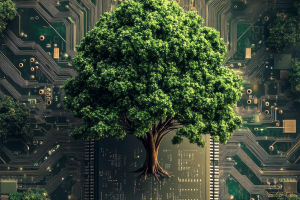AI Replace Human Artists?
The rapid advancement of artificial intelligence has already begun to transform industries from healthcare to finance. But one area where AI's impact is particularly interesting is the world of art.
AI-generated paintings have gained significant attention in recent years, with some works selling for eye-popping amounts at auctions.
This has led many to wonder: will AI replace human artists in the future? While the idea may seem far-fetched to some, it's worth considering the implications of AI's growing presence in the creative world.
Understanding AI in Art
AI-driven art tools have become increasingly sophisticated. Machine learning models such as OpenAI's DALL·E, Google's DeepDream, and Artbreeder can create breathtaking visuals based on simple text prompts or existing images. These systems use deep neural networks to analyze vast datasets of artwork and learn the nuances of style, color, composition, and texture. With such capabilities, AI can produce pieces that are visually stunning and often indistinguishable from those created by human hands.
But what does it mean for a painting to be "created" by a machine? Unlike a human artist who has intentions, emotions, and experiences that influence their work, AI doesn't "feel" the art it produces. Instead, it functions based on algorithms and data. So, while the output may be visually appealing, it may lack the depth, narrative, and subjective experience that human artists imbue their works with. Can this gap be bridged?
AI's Role as a Tool, Not a Replacement
While the idea of AI replacing human artists might make for an intriguing headline, it's more accurate to view AI as a powerful tool that enhances human creativity. In much the same way that photography did not eliminate painting but rather created new avenues for artistic expression, AI can be integrated into the artistic process to generate ideas, inspire new directions, and even assist with tedious aspects of art-making.
For instance, AI can help artists explore new styles or generate thousands of potential compositions in a fraction of the time it would take a human. Artists can use AI-generated works as starting points or sketches, adapting and refining them to reflect their own vision. In this way, AI acts as a collaborator, providing new perspectives and pushing the boundaries of what's possible in the realm of digital art.
The Unique Value of Human Creativity
Even as AI continues to evolve, there's something inherently irreplaceable about human creativity. Art is not merely about the final product; it's about the process—the struggle, the exploration, and the decisions made along the way. Human artists bring a personal, emotional touch to their work that cannot be replicated by machines. A painting might be beautiful, but the story behind it, the artist's journey, and the emotions that led to its creation are what make art deeply meaningful.
Consider the works of artists like Van Gogh or Picasso, whose personal lives and struggles are intricately woven into the fabric of their art. These nuances add layers of depth that go beyond aesthetics. An AI, no matter how advanced, simply cannot replicate this complex interplay of emotion, experience, and intention.
AI's Impact on the Art Market
The rise of AI-generated art is also shaking up the traditional art market. In 2018, an AI-generated portrait titled Edmond de Belamy sold for over $432,000 at auction, sparking debates about the value of AI-created art. Does a painting made by a machine hold the same cultural and financial worth as one created by a renowned artist?
Critics argue that AI art lacks the intangible qualities that give human-made art its value. However, some collectors and investors see AI-generated pieces as the future of art. As with any emerging technology, the financial and cultural worth of AI art will be shaped by the market's evolving perceptions. If AI-generated works become increasingly sophisticated, could we see a future where the distinction between human and machine-created art fades?
The Ethics and Authenticity of AI Art
Another important aspect of this debate revolves around ethics and authenticity. When AI is used to generate art, who owns the copyright? The software creator? The user who prompted the AI? Or perhaps no one at all? Currently, the legal framework around AI-generated works is murky, and it raises important questions about intellectual property, authorship, and originality.
Furthermore, some argue that AI-generated art undermines the very idea of art as a reflection of human experience. If a machine is the one creating the work, does it still carry the same meaning or cultural significance? While AI can mimic artistic styles, it lacks the lived experiences that shape human artistry. In this sense, art is more than just a product—it's a conversation between the creator, the audience, and the context in which the work exists.
AI as an Extension of Human Imagination
Rather than fearing AI as a threat to human creativity, we should consider its potential as a tool that expands our artistic horizons. It's important to remember that machines, at their core, are extensions of human knowledge and capability. Just as the camera didn't replace the painter, AI shouldn't be seen as a replacement for human artists. Instead, it can be an avenue for exploring new forms of expression, breaking down traditional boundaries, and pushing the limits of imagination.
As AI technology advances, it is likely that human artists will continue to experiment with and incorporate these tools into their work. The future of art may not be defined by machines taking over, but by the collaboration between human creativity and technological innovation.
So, will AI replace human artists? The short answer is no. AI has the potential to revolutionize how art is created and experienced, but it lacks the emotional depth and subjective experience that human artists bring to their work. Rather than replacing human creativity, AI offers artists new possibilities for collaboration, experimentation, and inspiration.
The future of art is not about machines overtaking human creativity; it's about how humans and AI can work together to unlock entirely new forms of artistic expression.
-
 Eco-Friendly ElectronicsHow Biodegradable Electronics Could Save the Planet One Device at a Time!
Eco-Friendly ElectronicsHow Biodegradable Electronics Could Save the Planet One Device at a Time! -
 Toner Pad Ratings!Which Pads Really Work? Swipe Through Top Picks That Refresh Skin And Boost Glow Instantly!
Toner Pad Ratings!Which Pads Really Work? Swipe Through Top Picks That Refresh Skin And Boost Glow Instantly! -
 Flower Arranging as ArtDiscover why floral design is more than just decoration—it's an art form.
Flower Arranging as ArtDiscover why floral design is more than just decoration—it's an art form.
Copyright © zogu 2021 - 2025. All Right Reserved.